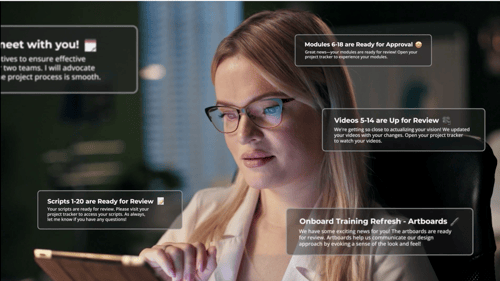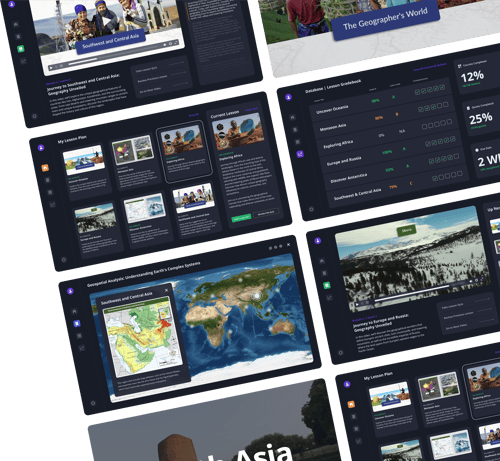E-Learning has exploded in popularity in recent years. It’s applicable to and being used in a wide variety of contexts, including higher education, alternative education, workplace training, and upskilling. The odds are high that you have participated in more than one of these types of e-learning, and the odds are better that you already know that not all e-Learning experiences are created equally.
Effective online learning experiences captivate the attention of the online student and promote their active involvement. In the absence of these elements, the effort and expense of creating online education or training content may be wasted. Here are some tips for making your e-Learning experience more engaging:
-
Stay Focused: Align Content & Activities with Learning Outcomes
-
Get It Together: Provide Clear, Consistent Organization & Structure
-
Mix It Up: Leverage a Variety of Learning Modalities
-
Practice Portion Sizing: Break Up Content into Manageable Chunks
-
Don’t Wait; Communicate! Provide Feedback Early & Often
-
Learning is Social: Don’t Overlook Community Building
-
Stay In the Game: Actively Participate in Course Delivery
1. Stay Focused: Align Content & Activities with Learning Outcomes
Begin with the end in mind. What do you want your learners to be able to do? What knowledge and skills will they need to be able to do it? How can they practice it in a low-pressure situation before demonstrating their level of mastery? Build your content delivery, activities, and assessments around the objectives you want them to achieve.
For example, if you need to teach your colleagues how to create a pivot table in Excel, you’ll need them to have access to the program and a data set. They will need to understand how to organize the data, insert the pivot table, select the appropriate pivot table fields, and interpret their results. You can show them these steps in a video, create a written guide, or demonstrate this in a one-on-one setting. Hands-on practice and feedback should be key components of your strategy, and these should take place before your colleagues need to deploy this skill in an important business case.
If you are the subject matter expert, you may enjoy talking about the subject in great detail, but overwhelming your audience is a common barrier that you can avoid. Ensure that the required content matches the desired learning outcomes and curate bonus or supplemental resources for those interested in learning more.
2. Get It Together: Provide Clear, Consistent Organization & Structure
The structure of your course itself will impact learner engagement. Well-organized content has a flow that invites the learner to take one more step all along the way and helps them stay on the path you’ve trailblazed. Learners are different, and some will struggle more with managing their own learning than with the content itself. Poorly organized content can prevent otherwise capable participants from achieving learning objectives.
Divide the material into modules or units that can be tackled in short periods of time, ideally one week or less. If deadlines are not necessary, provide a suggested completion date for each module to keep things rolling. Use status indicators so that your audience can gauge their own progress through the module. If the Learning Management System you use has a navigation page, such as the Modules page in Canvas, make sure that is accessible to your learners so that they have an idea of what to expect throughout the course.
3. Mix It Up: Leverage a Variety of Learning Modalities
Video is a powerful learning tool, and we highly encourage its use for better understanding and retention. Pair it with written content or other modalities to further enhance its impact. Consider introducing a video with a list of questions to consider while it’s being watched. This will help the majority of students remain engaged and increase understanding.
We learn by doing, so interactive content and hands-on activities should be incorporated wherever possible. Interactive content may include micro-learning, user-led experiences, guided readings, and review games. Real-world opportunities for discussion, discovery, and or practice should also be leveraged.
4. Practice Portion Sizing: Break Up Content into Manageable Chunks
The irony of creating digital learning content in the digital age is that competition for attention is fierce, and you can’t learn what you don’t attend to. You’ve probably consulted YouTube for an informational video at some point. Any chance you picked one of the shortest ones first? How many have you watched attentively beyond 10 minutes? 5 minutes? 3 minutes?
Chunk your content and activities into manageable periods of time. This should include most, if not all, types of activities in the learning journey. Informational readings are usually easy enough for readers to manage themselves, but make sure that you minimize the number of other activities that require lengthy single sessions. If these are necessary, give your learners an idea of how much time they should expect to spend so that they can plan accordingly.
Material organized in smaller segments makes it easier and more inviting to revisit it over time. Doing so at a frequency that aligns with our level of understanding also increases long-term retention.
5. Don’t Wait; Communicate! Provide Feedback Early & Often
Early feedback will indicate to your learners whether they have a solid foundation to move forward or if they need more support. Discovering that you don’t understand something after it’s had a negative impact on additional learning can be intensely demotivating. This is especially true for those who are putting in a good effort but lack understanding.
The example below involves content delivery and practice in a variety of environments. Feedback is also incorporated at several points along the learning journey. This allows the learner to apply what they learned from the feedback as opportunities to practice and apply the skill become more complex.
Consider your own capacity to provide personalized feedback during the delivery of your e-learning experience as you build it. If you anticipate this capacity to be low, be sure to leverage technology-driven assessment tools that can scale with a growing audience. Resist any temptation to be overly reliant on it and check out, though. Monitor for low performance and reach out with personalized feedback to help your struggling learners course-correct. Finally, consider using methods such as online office hours to provide opportunities for students to proactively seek feedback.
6. Learning is Social: Don’t Overlook Community Building
Social interactions and collaboration provide a rich and engaging learning experience that leads to better learning outcomes. When learners work collaboratively, they are actively engaged in the learning process, which can increase their motivation and help them retain information. Working together also requires learners to explain their reasoning and ideas to others, which can aid in developing their critical thinking and problem-solving skills. The diversity of perspectives and experience can enable learners to better understand a topic and challenge their assumptions. Social interactions encourage learners to develop important social and emotional skills, such as communication, teamwork, empathy, and respect for others.
Even if your material is asynchronous, or could be consumed outside of a regular online class time, consider creating cohorts of learners and pacing their activities if feasible so that they can interact and collaborate as they go. Create group work opportunities where possible, and do what you can to leverage the diversity among participants.
In the example below, a group project unfolded as basic stock and bond evaluation concepts were introduced, with the ultimate goal of preparing participants for portfolio construction in a future course. This project was an opportunity for hands-on practice within an asynchronous online course. Specific tasks were delegated to each team member. The group discussed their individual findings and collaborated to make selections from those presented, much like an investment committee might do. They did so using whatever collaborative methods and tools worked best for them.
7. Stay In the Game: Actively Participate in Course Delivery
Communities need leadership, and from many different angles. Learners who are so inclined will often take roles of leadership in your learning community, but don’t forget that you are still their guide. If you aren’t going to be leading the course, be sure to identify ways for the person who is to stay involved.
Encourage participants to interact with you and each other as they would if you were physically together. If possible, include opportunities for synchronous interactions, and weigh in on discussions. Provide a central place for introductions and getting to know one another. Doing the same for questions will have the added perk for you of decreasing repetitive individual responses.
You provide invaluable perspective, knowledge, and guidance as an active participant. Your participation will bring visibility to areas of friction or confusion and generate ideas for adjustments and updated material.
Remote learning experiences offer a variety of opportunities and benefits. Creating them with intention and with engagement in mind will enhance the teaching and learning experiences and lead to better outcomes. A well-structured e-learning experience – complete with a variety of learning modalities and community building – can engage students very effectively. Capture and guide the attention of your learners and improve learning outcomes by leveraging feedback, actively participating, and creating social interactions in your learning community.
Ready to see your learner engagement increase?
These seven tips are an excellent way to start improving overall engagement in your online courses. While these strategies hold true across the board when it comes to online learning, there are always approaches that will benefit your specific situation. Contact NextThought today to learn how we can enhance your course offerings with a custom solution.

NextThought team
NextThought transforms workplace learning through creative technology and engaging media. We're fortunate to partner with some of the top organizations in the world to make their educational training content remarkable and effective.
Recent Posts

What Can Go Wrong With A Custom Training Project? (And How NextThought Makes It Go Right)
August 5, 2025 1 Min Read

How Much Does a Custom Content Development Project Cost?
July 9, 2025 3 Min Read

The 6 Best Educational Video Production Companies (2025)
February 28, 2025 9 Min Read

